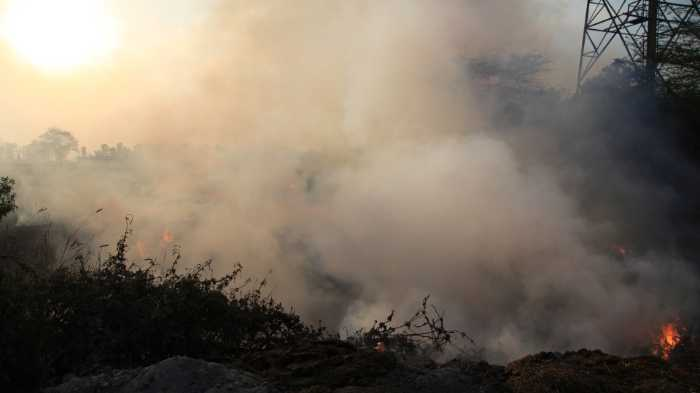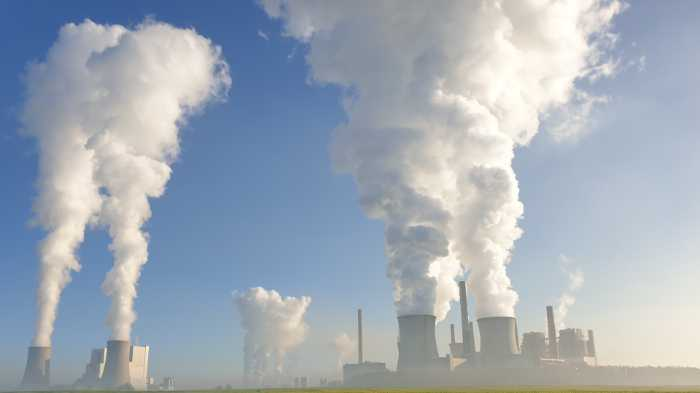
In order to understand the effects of black carbon on climate change, we must first understand what it is. Black carbon is a type of air pollutant that is created from the incomplete burning of fossil fuels, biomass, and waste. It is also known as soot or particulate matter. Black carbon has a large impact on climate change, but its effects are not well understood. In this article, we will discuss the science behind black carbon and its effects on the climate. We will also explore ways to reduce its impact on the environment.
What is the significance of black carbon?
Black carbon is a type of aerosolized carbon that is emitted when fossil fuels are burned. It is the product of incomplete combustion, and it is composed of soot, char, and ash. Black carbon is a major contributor to climate change, and it also has harmful effects on human health.
In the atmosphere, black carbon absorbs heat and contributes to global warming. When black carbon settles on snow and ice, it reduces the amount of sunlight that is reflected back into space, causing the snow and ice to melt. This process amplifies the warming effect of black carbon, and it also contributes to sea-level rise.
Black carbon also poses a threat to human health, as it can be inhaled deep into the lungs, which can cause respiratory problems. It has also been linked to cancer and heart disease. Reducing black carbon emissions is critical for protecting both the environment and public health.
How long do black carbon aerosols last in the atmosphere?

Black carbon aerosols can last for up to 10 years in the atmosphere. However, they are short-lived climate pollutants and typically only emitted for a few days or weeks before being removed by precipitation or settling out of the atmosphere. As a result, the overall lifetime of black carbon in the atmosphere is relatively short.
Nevertheless, black carbon can have a significant impact on climate over its brief lifetime. In addition, black carbon can also affect local air quality and contribute to respiratory problems. As a result, reducing black carbon emissions is an important goal for both mitigating climate change and protecting public health.
Is black carbon worse than carbon dioxide?

Black carbon is a type of fine particulate matter that is emitted as a result of fossil fuel combustion. Unlike carbon dioxide, which is a gas, black carbon particles are solid and can be suspended in the air for long periods of time. Because of their small size, black carbon particles can penetrate deep into the lungs and cause respiratory problems.
In addition, black carbon particles absorb heat and contribute to global warming. For these reasons, some experts believe that black carbon may be even more harmful than carbon dioxide. However, more research is needed to confirm this theory. In the meantime, it is clear that both black carbon and carbon dioxide are major pollutants that must be controlled in order to protect the environment.
What produces black carbon?
Carbon black is a short-lived climate pollutant that is a real worry for developing countries and the Arctic region. The most common sources of black carbon emissions are combustion engines, power plants, and industrial facilities.
Black carbon is also produced by forest fires, gas flaring, coal combustion, open biomass burning, diesel engines, and agricultural burning. Once black carbon particles are emitted into the atmosphere, they can be transported long distances by winds and can eventually settle on snow and ice surfaces. There, they can absorb heat from the sun and contribute to melting.
Black carbon is considered to be one of the most important climate-forcing agents due to its ability to both warm the atmosphere and contribute to the melting of snow and ice. Therefore, reducing emissions of black carbon is an important step in mitigating climate change.
Where do global black carbon emissions come from?

Black carbon is a major contributor to global warming and has been linked to a range of health problems, including respiratory diseases, cardiovascular disease, birth defects, and cancer. According to the World Health Organization, black carbon is responsible for 4.5 million premature deaths each year.
So who produces the most black carbon emissions? China tops the list, followed by India, Indonesia, and Brazil. Together, these four countries account for more than 36% of global black carbon emissions.
Reducing BC emissions will require a concerted effort from all countries, but it is clear that some will need to do more than others. In particular, China and India will need to take bigger action to address this growing problem.
Is black carbon man-made?

While black carbon is a naturally occurring substance, the vast majority of black carbon in the environment is the result of human activity. Burning fossil fuels releases black carbon into the atmosphere, where it can interact with other pollutants to form dangerous levels of air pollution.
Black carbon is also a major contributor to climate change, as it absorbs heat and contributes to the trapping of greenhouse gases in the atmosphere. As a result, reducing emissions of black carbon is essential to protecting both public health and the environment.
How do you measure black carbon?
Black carbon is a short-lived climate pollutant that is a serious worry for developing countries. There are a few ways to measure black carbon. One is to use an aethalometer, which measures the light absorption of particulate matter in the air.
Another is to use an optical reflectometer, which measures the reflectance of light off of particulate matter. Finally, black carbon can also be measured by thermal methods, which involve measuring the heat absorption and/or emission of particulate matter.
What is the difference between black carbon and organic carbon?
Black carbon and organic carbon are two types of atmospheric carbon. Black carbon is a product of combustion, such as from vehicles or power plants, and is composed of soot and other particles. Organic carbon, on the other hand, comes from living things and decomposing plant matter.
Both black carbon and organic carbon can contribute to climate change, but black carbon has a larger warming effect because it absorbs more heat than organic carbon. In addition, black carbon only stays in the atmosphere for a few days to weeks, while organic carbon can linger for centuries. Therefore, reducing emissions of black carbon is a more effective way to combat climate change in the short term.
What are the uses of black carbon?
Here are some of the most common uses for black carbon:
- Water filtration: Black carbon can be used to remove impurities from water, making it safer to drink.
- Solar energy absorption: Black carbon is an excellent material for absorbing solar energy. This makes it ideal for use in solar panels and other solar energy devices.
- Thermal insulation: Black carbon is a good insulator, meaning it can help keep buildings and other structures warm in cold weather.
- Electrical conductivity: Black carbon can be used to create electrical circuitry and other electronic components.
- Abrasion resistance: Black carbon is very resistant to wear and tear, making it ideal for use in industrial applications where high levels of friction are present.
How can we reduce the impact of black carbon on the environment?
There are a few ways to reduce the impact of black carbon on the environment:
- Reduce emissions from open burning of agricultural waste, such as straw burning and clearing of fields.
- Use cleaner technologies and fuels in households, such as improved cookstoves.
- Encourage the use of efficient stoves and fuels for commercial cooking, such as in restaurants and street vendors.
- Install filters on diesel generators.
- Switch to cleaner-burning fuels in industries, such as natural gas instead of coal or oil.
- Upgrade old coal-fired power plants with new technology, such as “scrubbers” that remove soot from exhaust fumes before they are released into the air.
- Promote the use of public transport, bicycles, and walking over private vehicles to reduce emissions from tailpipes.
Conclusion
Black carbon is a major component of air pollution, and its emissions need to be reduced in order to protect public health and the environment. There are a number of ways to measure black carbon, and it has a variety of uses, including water filtration, solar energy absorption, thermal insulation, electrical conductivity, and abrasion resistance. While black carbon has many positive uses, it also contributes to climate change and needs to be reduced in order to protect the environment. There are a number of ways to reduce BC emissions, such as reducing the open burning of agricultural waste, using cleaner technologies and fuels in households, and promoting the use of public transport.
FAQs

What are the main causes of greenhouse gas emissions?
Greenhouse gas emissions come from a variety of sources, but the primary cause is the burning of fossil fuels. When coal, oil, and natural gas are burned to produce energy, they release carbon dioxide into the atmosphere. Additional greenhouse gases are produced by industrial processes, wood burning, biomass burning, and forest fires. Diesel engines also contribute to greenhouse gas emissions, as they release particulates and other pollutants that can promote cloud formation and trap heat on Earth’s surface. As greenhouse gas emissions increase, the Earth’s climate is impacted in a number of ways. Temperatures rise, leading to higher sea levels and more extreme weather conditions. In addition, emissions reductions can have a number of health benefits, including reducing air pollution and improving public health.
How can we reduce the use of fossil fuels?
There are a number of ways to reduce the use of fossil fuels. One is to increase the efficiency of diesel engines. This can be done by retrofitting older engines or making sure that new engines meet the latest emissions standards. Another way to reduce fossil fuel use is to switch to cleaner-burning fuels such as natural gas. In addition, many industrial processes can be made more energy-efficient, which would also lead to reductions in fossil fuel use. Finally, methane emissions from coal mines and oil and gas production can be reduced by using better venting and capture technologies. Reducing the use of fossil fuels has a number of health benefits, including reducing greenhouse gas emissions and improving air quality, which can have positive impacts on the public.
How are black carbon concentrations affecting the Arctic?
Black carbon contributes to climate change by absorbing solar radiation and reducing the reflective capacity of polar ice. As a result, Arctic nations are working together through the Arctic Council to reduce black carbon emissions. International measures include the reduction of volatile organic compounds from ships operating in polar regions, as well as reduced air pollutants from industry and transportation.
What are some policies that could reduce black carbon emissions?
The International Maritime Organization has adopted new standards for ships that will reduce their emissions of black carbon and other air pollutants. The Canadian government has also introduced a Clean Fuel Standard that will require a gradual reduction in the use of high-carbon fuels such as gasoline and diesel.
What is Arctic Warming?
Arctic warming is the term used to describe the overall climate change that is happening in the Arctic. The main component of this change is the increased temperatures that are being seen in the region. This rise in temperature is causing a number of different impacts, including melting sea ice, thawing permafrost, and changes in plant and animal life. Arctic warming is also contributing to the formation of an Arctic haze, which is a layer of air pollution (climate pollutants) that can have harmful effects on human health on a global scale. While Arctic warming may seem like a far-off problem, it actually has impacts all around the world. As the Arctic warms, it can cause disruptions to global weather patterns, which can lead to more extreme weather events elsewhere. For example, a warm Arctic can weaken the jet stream, which can then cause cold air to spill into lower latitudes. This can lead to extended periods of cold weather and heavy snowfall. As such, it is important for people all over the world to be aware of Arctic warming and its potential effects.
What is incomplete combustion?
Incomplete combustion occurs when there is not enough oxygen present to allow the fuel to burn completely. This can happen if a fire is smothered or if the fuel is not of good quality. Incomplete combustion can produce harmful gases such as carbon monoxide, so it is important to make sure that a fire has enough oxygen to ensure complete combustion.

Dean Emerick is a curator on sustainability issues with ESG The Report, an online resource for SMEs and Investment professionals focusing on ESG principles. Their primary goal is to help middle-market companies automate Impact Reporting with ESG Software. Leveraging the power of AI, machine learning, and AWS to transition to a sustainable business model. Serving clients in the United States, Canada, UK, Europe, and the global community. If you want to get started, don’t forget to Get the Checklist! ✅
